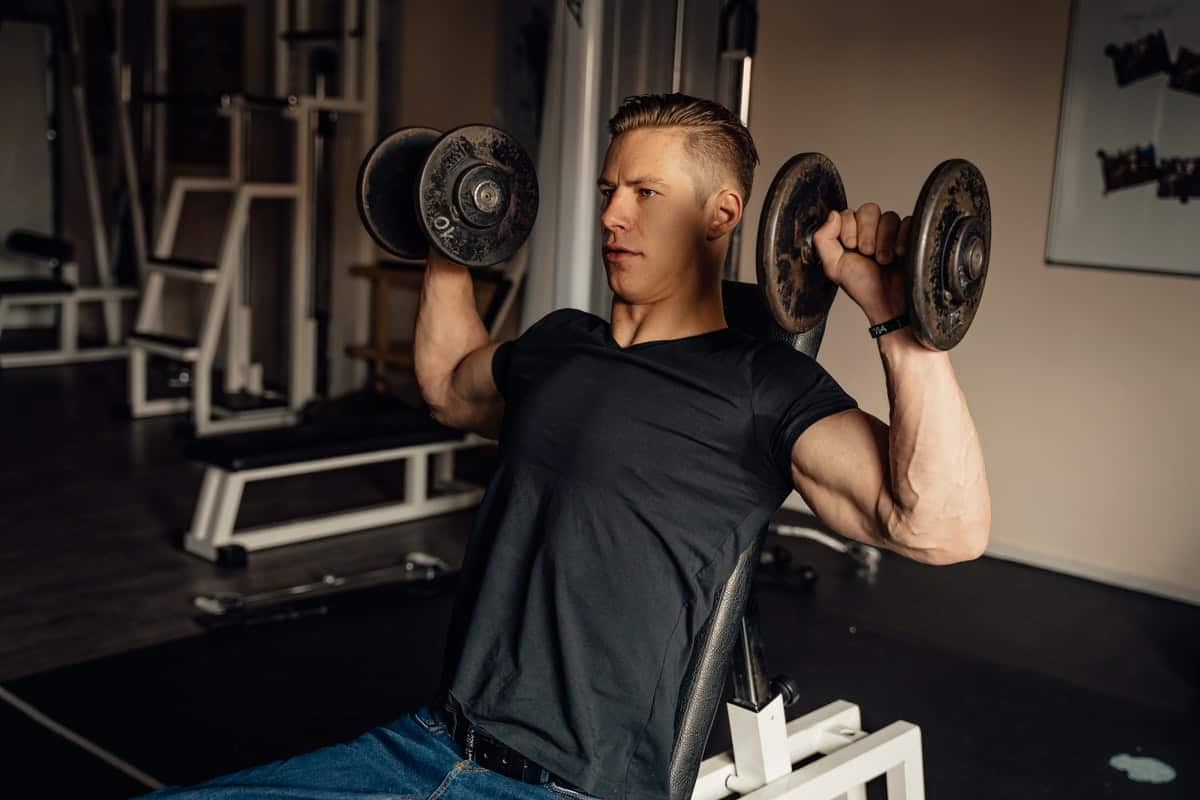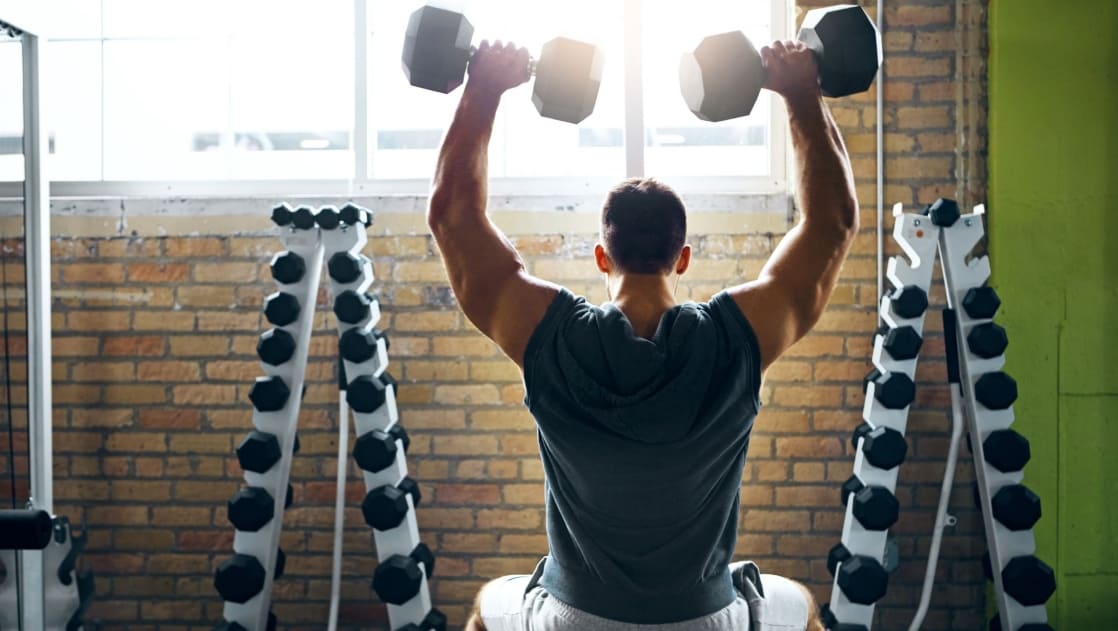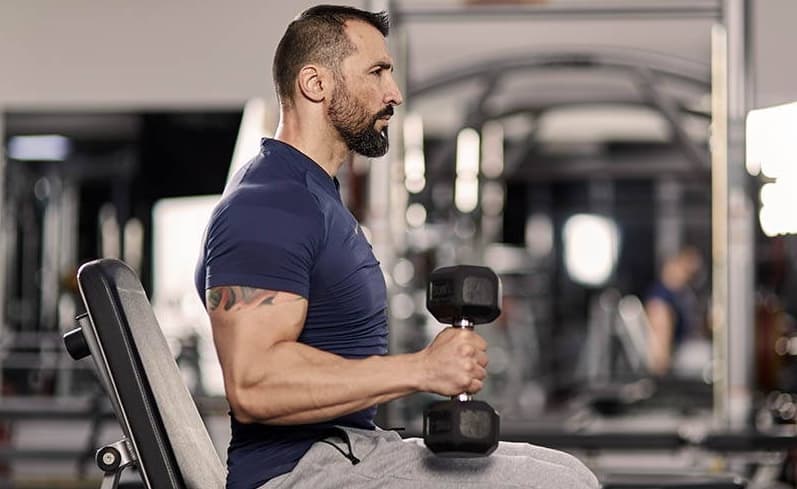The Arnold press is a very complete exercise developed years ago by bodybuilder Arnold Schwarzenegger. In this exercise, the deltoids and triceps work synergistically to achieve a very complete exercise for our upper body.
It is an exercise that very few perform when working out the shoulders, but it can be our perfect ally to activate our deltoids.
The execution is relatively simple, although we must master the twist that the execution of this exercise implies, and for this, what we can do is start performing this type of press with little load to get used to its execution and feel the activation fully.
What is the Arnold press?
The Arnold press, is a compound push exercise that works the three sections of the deltoids and undoubtedly serves to hypertrophy and improve the strength of our shoulders.
The shoulder is a delicate joint, therefore, it is advisable to learn the execution technique so that there are no injury problems in said joint.
It should be noted that this shoulder exercise is performed exclusively with dumbbells or kettlebells, being impossible to perform with a barbell.
Who invented the Arnold press?
Arnold Schwarzenegger, a bodybuilder who began strength training as a teenager and won the title of Mr. Universe at twenty years old and then achieved seven victories in the Mister Olympia competition between 1970 and 1980.
During his preparation and career, he popularized this exercise, coining it the name Arnold press.
In some countries, it is also called Scoot Press because at that time Schwarzenegger helped Larry Scott turn his weakest point in bodybuilding (his shoulders) into one of the most remarkable points and thanks to that he achieved Mr. Olympia.
Figure 1. Arnold Schwarzenegger.How to do the Arnold press?
The Arnold press can be done standing or seated, but for better safety in the lower back, we will explain the seated Arnold press technique.
- We will sit on a bench holding a dumbbell in each hand with arms bent and placing both dumbbells at shoulder height with the palms of our hands facing us.
- With this position, instead of simply pushing upwards, we will perform a twist/rotation of the dumbbells to end up performing a shoulder press.
- We will begin the eccentric phase in a controlled manner and perform the reverse twist, rotating until the palms of the hands face us again and thus return to the starting position.
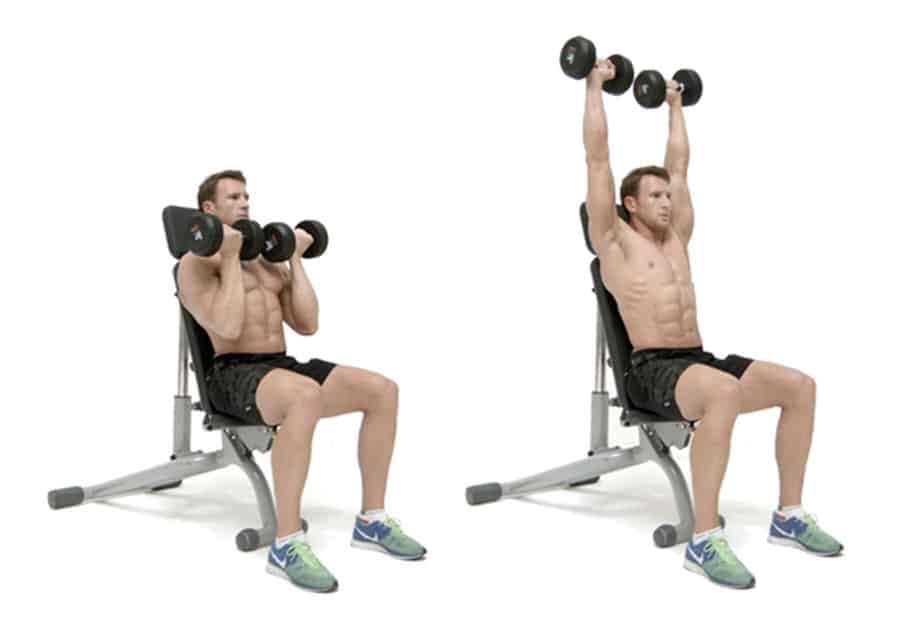
Tips for correct execution of the Arnold press
It is very important to keep the back properly supported on the bench, avoiding excessive lumbar arches lumbar and also, we must have a total activation of our core muscles, this will cause greater transfer to the exercise.
It is recommended to perform the Arnold press seated if you have problems in the lower back.
If you have a shoulder injury, it is better to continue with the regular shoulder press. Sometimes, the rotational movement of the Arnold press can put too much pressure on an irritated shoulder joint.
Always take care of your neck position, avoid transferring tension to it and keep your cervical spine in a neutral position, extending the line of the spine. Do not move your head forward.
Another important tip is to avoid total elbow lockout at the end of the concentric phase, this will protect your elbow joint and also promote greater activation of the deltoid, as it will have more time under tension.Do not perform the eccentric phase too quickly, if you are forced to do so, you may be moving too much load.
Avoid loading excessive weight, with quite light loads the exercise performs its function perfectly and you will achieve correct activation of the deltoid. Focus on a controlled eccentric phase.
Avoid performing the exercise discontinuously, that is, in several phases, as if they were several movements. You must perform the twist naturally and continuously.
The movement should not be interrupted or stopped. That is, many people first raise the dumbbells, and when lowering them, they position them on the sides of the shoulders, interrupting the continuous movement to later position them in front of the chest. This would be a mistake.
What muscles do you work in the Arnold press?
In the Arnold press, a large number of muscles are involved, despite being quite specific for deltoids, it is considered a compound exercise mechanically due to the number of muscles involved.Additionally, it is an exercise that requires great activation of the stabilizing muscles.
The target muscle of this exercise is the deltoid in its entirety, with emphasis on the anterior portion. Due to the twist necessary to execute the movement, the supraspinatus, triceps brachii, middle and lower trapezius, and anterior serratus are recruited as synergist muscles.
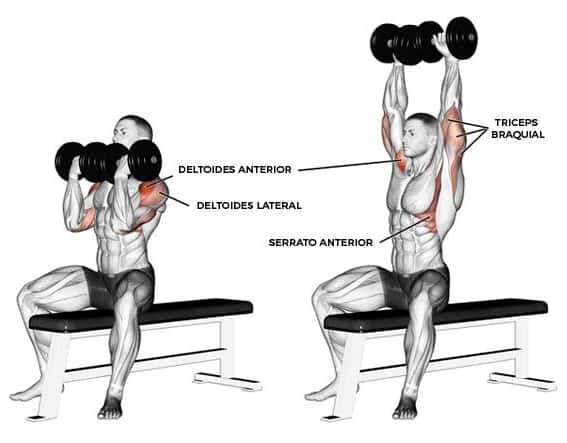
A scientific study analyzed the muscle activation of the anterior and medial deltoid muscles while performing a normal shoulder press and an Arnold press.
Participants performed 5 repetitions of each of the dumbbell exercises. Surface electromyography (SEMG) was used to record muscle activation and efficiently measure the muscle electrical activity produced during contraction.
The results were that the anterior and medial deltoid muscles were more activated while performing the Arnold press compared to the normal shoulder press.
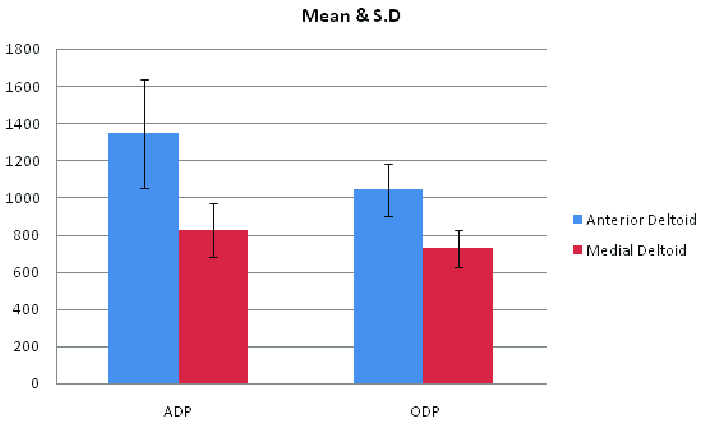
The Arnold press demonstrated in this research to be a more effective exercise for the activation of the anterior and medial deltoid muscles compared to the dumbbell shoulder press.
The anterior deltoid acts as the primary muscle while performing both exercises, as muscle activation is much greater compared to the medial deltoid.
Variations and progressions of the Arnold press
The Arnold press lends itself to various variations and progressions that you can use to challenge your shoulders and maintain motivation in your workouts. Here are some options you can consider:
- Seated Arnold press: Performing the Arnold press in a seated position provides you with additional stability and allows you to focus exclusively on the shoulders. You can use a bench or a specialized machine for greater comfort.
- Unilateral Arnold press: Instead of using both dumbbells simultaneously, perform the exercise unilaterally, alternating arms. This helps correct muscle imbalances and develop greater stability.
- Arnold press with Z bar: If you prefer to use a bar instead of dumbbells, you can opt for the Arnold press with a Z bar. This variation changes the grip and hand position, which can generate a slightly different stimulus in the muscles.
Benefits of the Arnold press
If you introduce the Arnold press as a shoulder exercise in your routine, you will benefit from the following aspects:
- You will improve posture by activating the core muscles.
- You will hypertrophy the three heads of the deltoid.
- If you have some muscle imbalance in the shoulders, you should add this exercise to your routine.
- It is an exercise that promotes a high time of work under tension to our deltoids.
- You will have positive transfer to other heavier push exercises (such as the military press).
- Another of the main benefits of the Arnold press is that it provides a high range of motion, that is, all areas of the shoulder are worked. In this way, the Arnold press allows for a stronger contraction, which favors muscle development.
The Arnold press demonstrated in this research to be a more effective exercise for the activation of the anterior and medial deltoid muscles compared to the dumbbell shoulder press.
Develop steel shoulders
The Arnold press has become a favorite among fitness enthusiasts for its numerous benefits and its ability to effectively strengthen and develop the shoulders. Let’s see why you should consider including this exercise in your training routine:
- Stronger shoulders: The Arnold press is one of the best exercises to develop shoulder strength. It works the deltoids in a balanced way, helping you achieve a more symmetrical and proportionate appearance.
- Muscle definition: By performing the Arnold press, you will be working both the large and small muscles of the shoulders. This will allow you to achieve more pronounced muscle definition and a toned appearance.
- Stability and balance: The Arnold press also involves the core stabilizing muscles, which helps improve overall stability and balance. This will be useful both in your workouts and in daily activities.
“The Arnold press is the path to strong and powerful shoulders. Boost your physique and stand out in your workouts!” – Anonymous
Conclusion
As we have seen on many occasions, the shoulder is one of the parts that is most difficult for us to develop when training.
It is important that we choose the most appropriate training to directly target all the muscles that make up the shoulder.
This exercise became popular in bodybuilding thanks to Arnold Schwarzenegger and activates the 3 heads of the deltoid. It is a simple exercise that we must consider when training the upper body.
The execution of the Arnold press is simple, but it requires mastering the technique at the beginning. If we are beginners, we must ensure the technique with very light loads to later perform the exercise with more weight.
It is very important to have a correct placement of the back and keep the cervical spine without tension, extending the line of the spine.
In this compound exercise, the deltoids are mainly worked, however, the activation of a large number of synergist muscles is required.
The Arnold press is a very complete shoulder exercise, however, we must take care of the technique at all times and also take care of the descent of the eccentric phase.
Course on Muscle Hypertrophy
If you want to learn more about the Barbell Row and how to get the most out of your workouts. We recommend our Course on Muscle Hypertrophy, based on the latest scientific studies.
En este curso vamos a tratar el entrenamiento de la fuerza orientada a la hipertrofia muscular, buscando las formas de optimizar el proceso a la hora de planificar las cargas y las sesiones de entrenamiento.
Aprenderemos a determinar cuándo nos interesa conseguir esa hipertrofia, cómo esta afecta a los niveles de fuerza y la importancia de conocer el estado inicial de la persona que se someta a este tipo de entrenamiento.
Podcast “Arnold Press: A perfect exercise for your shoulders”: Play in new window |
Subscribe to Apple Podcasts | Spotify | Google Podcasts |
Bibliographic references
- Shiny Raizada Amritashish Bagchi (2017). Comparison among the EMG Activity of the Anterior Deltoid and Medial Deltoid During Two Variations of Dumbbell Shoulder Press Exercise. Indian Journal of Public Health Research and Development 8(4):653.
- Williams, J. M., Hendricks, D. S., Dannen, M. J., Arnold, A. M., & Lawrence, M. A. (2018). Activity of Shoulder Stabilizers and Prime Movers During an Unstable Overhead Press. Journal of Strength and Conditioning Research.
- Escalante, G. (2017). Exercise modification strategies to prevent and train around shoulder pain. Strength & Conditioning Journal, 39(3), 74-86.
- Salles, J. I., Velasques, B., Cossich, V., Nicoliche, E., Ribeiro, P., Amaral, M. V., & Motta, G. (2015). Strength training and shoulder proprioception. Journal of Athletic Training, 50(3), 277-280.
